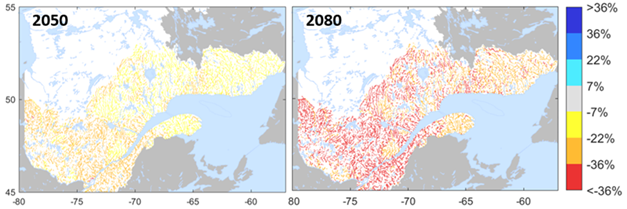Water availability and quality
Water Availability
Throughout the 21st century, climate change will have an impact on water availability in Quebec. In this regard, it may become more scarce both in streams and lakes as well as in larger water systems such as the Great Lakes and the St. Lawrence River. According to the Hydroclimatic Atlas of Southern Quebec, baseflow periods in Quebec’s watercourses in summer and fall are projected to be increasingly severe. In fact, periods of low water levels could be longer in duration and baseflows could decline.
The Hydroclimatic Atlas describes the current and future hydrological regime of southern Quebec with the objective of supporting the implementation of water management practices that are resistant to climate change.
In the case of the Great Lakes and the St. Lawrence River, low water level episodes are projected to occur more frequently in late summer and autumn. A large degree of uncertainty subsists, however, for this highly complex hydrological system.
Beyond the impacts of climate change, it is important to take into consideration the many users that put added pressure on water availability during the baseflow period. This could have impacts on drinking water supply, ecosystems, agricultural activities, industrial activities, recreational activities, hydroelectric power production, fishing, shipping, or local property values.
For example, the Yamaska watershed is particularly vulnerable to more prolonged baseflow periods notably due to climate change, as its summer discharge is already low. A number of municipalities and industries in southern Quebec depend on the Yamaska River for their water supply.
Definition | Baseflow
Baseflow is defined as the minimum discharge of a watercourse or lake during a dry period.
Water Quality
Deteriorating water quality is a major issue caused by a combination of multiple anthropogenic pressures, including industrialization, urbanization, agricultural activities, tourism and the absence or insufficiency of certain wastewater treatment systems, etc. The aggravation of baseflow periods mentioned above could exacerbate water quality issues since it will limit the dilution capacity of surface and groundwater.

Figure 1: Summer-autumn minimum of the 7-day mean flow with a 2-year return extrapolated to 2050 and 2080, RCP8.5, compared to historic period of 1970-2022. Q7MIN2EA. Source: DEH, 2022. Hydroclimatic Atlas of Southern Québec.
On the other hand, rising water temperatures caused by global warming could permit the proliferation of algae, including cyanobacteria, pathogens, and toxic bacteria in water bodies. The presence of these elements represents a health concern, as it affects water quality and can potentially make it unsuitable for bathing and consumption.
Climate change will also lead to an intensification of heavy rain episodes over the coming decades. In urban environments, such a situation can cause congestion and overflow in wastewater collection systems as well as the transport of significant quantities of polluted and contaminated water (pathogens, metals, phosphorous, etc.) in nearby watercourses. Through a ripple effect, aquatic ecosystems are then made more fragile or even threatened, as are opportunities for practising recreational activities in and on these water bodies due to health concerns.
Photo : Le Canada Français - Archives